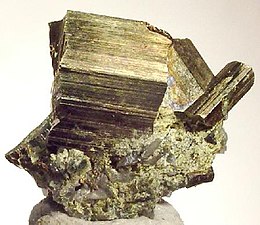| Cubanite | |
|---|---|
 Striated, cyclically-twinned cubanite crystals from the Chibougamau mines of Quebec (size: 1.5 × 1.3 × 1.0 cm) | |
| General | |
| Category | Sulfide mineral |
| Formula (repeating unit) | CuFe2S3 |
| IMA symbol | Cbn[1] |
| Strunz classification | 2.CB.55a |
| Crystal system | Orthorhombic |
| Crystal class | Dipyramidal (mmm) H-M symbol: (2/m 2/m 2/m) |
| Space group | Pcmn |
| Unit cell | a = 6.467(1) Å, b = 11.117(1) Å, c = 6.231(2) Å; Z = 4 |
| Identification | |
| Color | Bronze to brass-yellow |
| Crystal habit | Crystals elongated to thick tabular, striated also massive |
| Twinning | Common with twin plane {110} in pairs, also as fourlings and pseudohexagonal sixlings |
| Cleavage | Parting on {110} and {130} |
| Fracture | Conchoidal |
| Mohs scale hardness | 3.5–4 |
| Luster | Metallic |
| Streak | Black |
| Diaphaneity | Opaque |
| Specific gravity | 4.0–4.2 |
| Optical properties | Distinctly anisotropic on polished surface |
| Other characteristics | Strongly magnetic |
| References | [2][3][4] |
Cubanite is a copper iron sulfide mineral that commonly occurs as a minor alteration mineral in magmatic sulfide deposits. It has the chemical formula CuFe2S3 and when found, it has a bronze to brass-yellow appearance. On the Mohs hardness scale, cubanite falls between 3.5 and 4 and has a orthorhombic crystal system.[2] Cubanite is chemically similar to chalcopyrite; however, it is the less common copper iron sulfide mineral due to crystallization requirements.
Cubanite occurs in high temperature hydrothermal mineral deposits with pyrrhotite and pentlandite as intergrowths with chalcopyrite.[4] It results from exsolution from chalcopyrite at temperatures below 200 to 210 °C.[4] If cubanite is exposed to temperatures above 210 °C, it will transform into isocubanite. After this transformation, if it begins to cool, it will not revert to cubanite.[5] Upon its transformation to isocubanite it will lose its highly magnetic property due to its change from an orthorhombic to a cubic crystal structure.[6] Cubanite has been identified on chondrites and within dust grain samples and has improved the precision of copper isotope analysis.
- ^ Warr, L.N. (2021). "IMA–CNMNC approved mineral symbols". Mineralogical Magazine. 85 (3): 291–320. Bibcode:2021MinM...85..291W. doi:10.1180/mgm.2021.43. S2CID 235729616.
- ^ a b Mindat.org
- ^ Webmineral
- ^ a b c Handbook of Mineralogy
- ^ Chandra, U.; Parthasarathy, G.; Sharma, P. (2010-10-01). "SYNTHETIC CUBANITE CuFe2S3: PRESSURE-INDUCED TRANSFORMATION TO ISOCUBANITE". The Canadian Mineralogist. 48 (5): 1137–1147. Bibcode:2010CaMin..48.1137C. doi:10.3749/canmin.48.5.1137. ISSN 0008-4476.
- ^ Sawada, M.; Ozima, M.; Fujiki, Y. (1962). "Magnetic Properties of Cubanite (CuFe2S3)". Journal of Geomagnetism and Geoelectricity. 14 (2): 107–112. Bibcode:1962JGG....14..107S. doi:10.5636/jgg.14.107. ISSN 0022-1392.